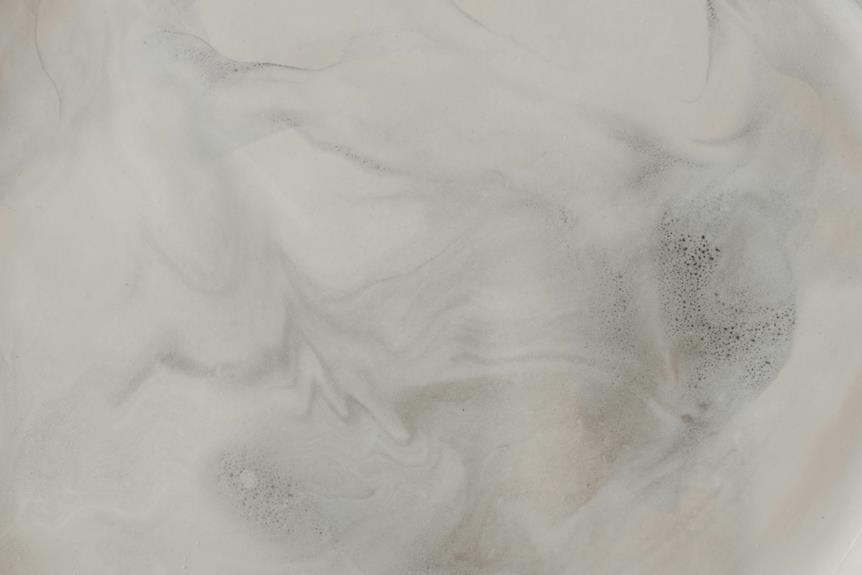When it comes to dealing with stubborn coffee stains or the pesky grease marks that seem to find their way onto our marble surfaces, we often find ourselves at a loss for effective solutions. However, fear not, for in our discussion ahead, we will uncover practical methods for removing common household stains from marble through simple yet powerful techniques.
From tackling wine spills to combating ink stains and even rust removal, the secrets to restoring your marble's pristine appearance are just a scroll away.
Key Takeaways
- Blot coffee stains gently with warm water and mild dish soap.
- Use baking soda paste for espresso stains, let sit, then wipe clean.
- Treat grease marks with baking soda paste, vinegar, and gentle scrubbing.
- Act quickly with hydrogen peroxide solution for effective wine spill removal.
Coffee Stains
When dealing with coffee stains on marble surfaces, we typically start by gently blotting the affected area with a soft cloth. Tea spills can be just as pesky, but fear not, as we've got you covered. For these stubborn stains, a mixture of mild dish soap and warm water usually does the trick. Simply dampen a cloth with the solution and gently dab at the affected area until the stain lifts.
Carpet cleaning can be a hassle, especially when spills happen. But espresso drips on marble? That's a different story. Quick solutions are our specialty. If you're facing espresso stains, a paste of baking soda and water can work wonders. Apply the paste to the stain, let it sit for a bit, and then wipe clean with a damp cloth. Voila! Your marble surface looks as good as new.
With these simple yet effective methods, you can bid farewell to coffee, tea, and espresso stains on your beautiful marble surfaces.
Grease Marks
Dealing with grease marks on marble surfaces can be effectively tackled using a mixture of baking soda and vinegar for optimal stain removal. When faced with oil stains or kitchen messes on your marble countertops or floors, follow these simple steps:
- Create a Paste: Mix baking soda and water to create a paste. Apply this paste directly to the grease marks on the marble surface, ensuring it covers the stains completely.
- Add Vinegar: Sprinkle some vinegar over the baking soda paste. The combination of these two ingredients will react and create a foaming action that helps break down the grease and lift it from the marble.
- Scrub Gently: Use a soft-bristled brush or a damp cloth to gently scrub the paste into the grease marks. Let it sit for a few minutes before rinsing it off with warm water and drying the area thoroughly.
Wine Spills
To effectively address wine spills on marble surfaces, a solution of hydrogen peroxide and water can be utilized for efficient stain removal. When dealing with red wine spills, it is crucial to act quickly to prevent the stain from setting into the porous surface of the marble. Mix equal parts hydrogen peroxide and water in a spray bottle and apply it to the affected area. Let it sit for 5-10 minutes before gently blotting the stain with a clean cloth. For white wine spills, a similar approach can be taken for effective removal. Here is a simple guide on how to tackle wine spills on marble:
| Wine Type | Cleaning Solution |
|---|---|
| Red Wine | Hydrogen Peroxide + Water |
| White Wine | Hydrogen Peroxide + Water |
Ink Stains
Ink stains on marble surfaces can be effectively removed using a mixture of acetone and water. When dealing with pen marks or stubborn permanent marker stains on your beautiful marble countertops or floors, follow these simple steps to restore the pristine look of your surfaces:
- Acetone Solution: Mix equal parts of acetone and water in a small bowl. Dip a clean cloth into the solution and gently dab the ink stain. Avoid rubbing vigorously to prevent spreading the ink further.
- Blotting Technique: Place a paper towel over the treated area and apply gentle pressure to blot the ink. This helps absorb the ink and acetone mixture, lifting the stain from the marble surface.
- Repeat if Necessary: For tougher stains, reapply the acetone and water solution and continue the blotting process until the ink stain fades. Be patient and persistent for best results.
Rust Removal
When tackling rust stains on marble surfaces, a vinegar and water solution can be a highly effective remedy. Mix equal parts of vinegar and water in a spray bottle and apply it directly to the rust stain. Let it sit for a few minutes to penetrate the stain before gently scrubbing with a soft brush or cloth. The acidic properties of vinegar help break down the rust, making it easier to remove without damaging the marble.
To prevent metal discoloration and oxidation removal in the future, consider using coasters or mats under metal objects to avoid direct contact with the marble surface. Regularly clean and dry marble surfaces to prevent moisture buildup, which can contribute to corrosion. Additionally, applying a marble sealer can help protect the surface from rust stains and aid in surface restoration.

